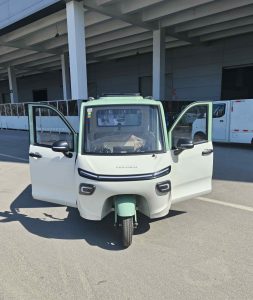คำแนะนำ
คำถาม "รถไฟฟ้าทํางานอย่างไร" จับภาพความน่าสนใจมากมายรอบ รถไฟฟ้า (EV) การปฏิวัติ ในขณะที่ผู้ผลิตรถยนต์และรัฐบาลก้าวหน้าด้วยการใช้ไฟฟ้า ความเข้าใจกลไกพื้นฐาน ตั้งแต่ระบบแบตเตอรี่จนถึงมอเตอร์ไฟฟ้า ตั้งแต่อิเล็กทรอนิกส์พลังงานจนถึงการเบรกแบบฟื้นฟ ในบทความนี้ เรา demystify วิธี รถไฟฟ้า ทำงาน, อธิบายข้อดีและความท้าทายของ รถไฟฟ้า กลและดูที่ที่นวัตกรรมกำลังมุ่งหน้าใน รถยนต์ EV พื้นที่เครื่องขับเคลื่อน

I. สถาปัตยกรรมพื้นฐาน: แบตเตอรี่, อินเวอร์เตอร์และแอมป์ มอเตอร์
1.1 แบตเตอรี่: หัวใจของระบบ
เมื่อถาม “ทำอย่างไร รถไฟฟ้า งานแบตเตอรี่มักจะเป็นส่วนประกอบแรกที่มาถึงใจ ไม่เหมือนรถยนต์เครื่องยนต์เผาไหม้ภายใน (ICE) ที่พึ่งพาถังเชื้อเพลิง รถไฟฟ้าเก็บพลังงานในแบตเตอรี่ขนาดใหญ่ แพ็คเกจเหล่านี้ประกอบด้วยเซลล์แต่ละตัวหลายตัว มักจะใช้ลิเธียมไอออน จัดเรียงเป็นชุดและขนานเพื่อให้บรรลุแรงดันและความจุที่ต้องการ
ผู้ผลิตเลือกชนิดเซลล์ที่แตกต่างกัน ถุง, ทรงกระบอก, prismatic เพื่อสมดุลความหนาแน่นของพลังงาน, ค่าใช้จ่าย, ความมั่นคงทางความร้อน, และบรรจุ ตัวอย่างเช่น Mach-E ของฟอร์ดใช้เซลล์กระเป๋า ในขณะที่ Tesla ใช้เซลล์ทรงกระบอก เคมีเซลล์แต่ละเซลล์ (เช่น NCM, LFP) มีการแลกเปลี่ยนในค่าใช้จ่าย อายุยาว ประสิทธิภาพเย็น และการส่งพลังงาน
1.2 การแปลง DC เป็น AC: อินเวอร์เตอร์และแอมป์ อิเล็กทรอนิกส์พลังงาน
แบตเตอรี่ส่ง DC (กระแสตรง) แต่มอเตอร์ไฟฟ้าส่วนใหญ่ทํางานด้วย AC (กระแสสลับ) นั่นหมายความว่าส่วนหนึ่งของวิธี รถไฟฟ้า งานเกี่ยวข้องกับการแปลง DC จากแบตเตอรี่เป็น AC สําหรับมอเตอร์ นี่ถูกจัดการโดยอินเวอร์เตอร์
อินเวอร์เตอร์ยังควบคุมแรงดันไฟฟ้า กระแสไฟฟ้า และความถี่ เพื่อควบคุมความเร็วและแรงบิดของมอเตอร์ นอกจากนี้ สถาปัตยกรรมอิเล็กทรอนิกส์พลังงาน จัดการกับการเปลี่ยนแปลงแรงดันไฟฟ้า (เพิ่มขึ้น / ลง) การติดตามความปลอดภัย และการสื่อสารระหว ชั้นควบคุมนี้สําคัญในการ รถยนต์ EV การทํางาน
1.3 การออกแบบมอเตอร์และแอมป์ หลักการแม่เหล็ก
ในใจกลางของวิธี รถไฟฟ้า การทำงานเป็นมอเตอร์เอง ส่วนใหญ่พึ่งพาความแม่เหล็กไฟฟ้า: สเตเตอร์ (ส่วนที่คงที่) ผลิตสนามแม่เหล็กหมุนซึ่งดึงโรเตอร์ (ส่วนที่เคลื่อนไหว) กับมัน ผลลัพธ์: แรงบิดที่หมุนล้อ
มีหลาย topologies มอเตอร์ที่ใช้ - แม่เหล็กถาวร synchronous มอเตอร์ (PMSM), AC induction มอเตอร์ และสวิตช์มอเตอร์ความไม่ต้องการ แต่ละมีจุดแข็ง: PMSM มักจะให้ประสิทธิภาพสูงและแรงบิดที่แข็งแกร่งความเร็วต่ำ มอเตอร์เหนี่ยวนำหลีกเลี่ยงการใช้แม่เหล็กโลกหายาก มอเตอร์ความไม่ต้องการที่สวิตช์ให้ความแข็งแกร่งและความง่ายดายในการออกแบบบางอย่าง
มอเตอร์สามารถใช้ได้ในรูปแบบที่แตกต่างกัน: มอเตอร์เดียว (ด้านหลังหรือด้าน), มอเตอร์คู่ (ขับเคลื่อนทั้งหมด) หรือแม้กระทั่งมอเตอร์หนึ่งต่อล้อในรุ่นที่ม
ที่สอง ระบบสนับสนุนและ การฟื้นฟูพลังงาน
2.1 การเบรคฟื้นฟู: การกู้คืนพลังงานที่สูญเสีย
คุณสมบัติสําคัญหนึ่งในวิธีการทำงานของรถไฟฟ้าคือเทคโนโลยีเบรกแบบฟื้นฟู แทนที่จะสูญเสียพลังงานเคลื่อนไหวทั้งหมดเป็นความร้อนในเบรกแรงเสียดทานแบบดั้งเดิม รถไฟฟ้า สามารถใช้มอเตอร์ของพวกเขาในทางกลับกัน เพื่อทํางานเป็นเครื่องกำเนิดไฟฟ้า แปลงการเคลื่อนไหวกลับไปเป็นไฟฟ้า และส่งกลับไปยังแบตเตอรี่
การฟื้นฟูพลังงานนี้ปรับปรุงประสิทธิภาพ ขยายระยะการขับรถ และลดการสึกหรอของเบรคทางกลไก อย่างไรก็ตาม ประสิทธิภาพของเบรคฟื้นฟูลดลงที่ความเร็วต่ำ ดังนั้นเบรคแรงเสียดทานทั่วไปยังคงจำเป็น
2.2 การจัดการความร้อน, ระบบเสริม & การควบคุม
การรักษาอุณหภูมิแบตเตอรี่และมอเตอร์เป็นสิ่งสำคัญสําหรับประสิทธิภาพและอายุการใช้งาน ระบบความเย็น (ของเหลวหรืออากาศ) เครื่องทำความร้อน (สําหรับสภาพอากาศเย็น) ระบบการจัดการแบตเตอรี่ (BMS) และระบบอิเล็กทรอนิกส์ย่อยให้แน่ใจว่าเซลล
นอกจากนี้ รถไฟฟ้า รวมถึงระบบย่อยเสริมสําหรับแสง, ข้อมูลบันเทิง, HVAC, เซนเซอร์ และการเชื่อมต่อ เหล่านี้โดยทั่วไปทำงานบนแรงดันไฟฟ้า DC ต่ำ (มักจะ 12V / 48V) ที่จัดการจากแบตเตอรี่หลักผ่านตัวแปลง DC-DC
III. ข้อดี, ความท้าทาย & ถนนข้างหน้า
3.1 ประโยชน์: ประสิทธิภาพ, ความเรียบง่าย & ประสบการณ์ขับรถ
เข้าใจวิธี รถไฟฟ้า งานเปิดเผยข้อดีที่เกิดขึ้นจำนวนมาก:
แรงบิดทันทีจากศูนย์ RPM ทําให้ความเร่งอย่างรวดเร็วในการขับรถในเมือง
ชิ้นส่วนเคลื่อนย้ายน้อยลง → การบำรุงรักษาต่ำกว่า (ไม่มีการเปลี่ยนน้ำมัน, ของเหลวน้อยกว่า)
เบรกฟื้นฟูช่วยประสิทธิภาพพลังงาน
การทำงานที่เงียบสงบและราบรื่นช่วยเพิ่มความสะดวกสบาย
เพราะว่า รถไฟฟ้า ขาดคลัทช์, การส่ง, และรถยนต์ขับเคลื่อนที่ซับซ้อน, ความซับซ้อนทางกลลดลง.
3.2 ความท้าทาย: ช่วง, การชาร์จและแอมป์ โครงสร้างพื้นฐาน
อย่างไรก็ตาม รถไฟฟ้า งานยังเน้นความท้าทาย:
น้ำหนักและค่าใช้จ่ายของแบตเตอรี่ยังคงเป็นอย่างมาก
การชาร์จยังคงล้าช้าความเร็วในการเติมเชื้อเพลิง การชาร์จอย่างรวดเร็ว DC ช่วย แต่ต้องการโครงสร้างพื้นฐาน
ความวิตกกังวลระยะยังคงอยู่สําหรับการเดินทางที่ยาว โดยเฉพาะอย่างยิ่งในสภาพเย็นหรือรุนแรง
การย่อยสลายในเวลาลดความจุและประสิทธิภาพของแบตเตอรี่
ผู้ใช้หลายคนต้องวางแผนความพร้อมในการชาร์จอย่างระมัดระวัง การชาร์จในบ้านกลางคืนเป็นสิ่งที่เหมาะสม แต่ไม่ใช่ทุกคน (เช่น ผู้อาศัยอพาร์ทเมนต์
3.3 ทิศทางในอนาคตในนวัตกรรมของ EV Powertrain
เมื่อความต้องการเพิ่มขึ้น นวัตกรรมใหม่ใน รถไฟฟ้า กลและกล รถยนต์ EV การออกแบบเครื่องยนต์กำลังเกิดขึ้น
แบตเตอรี่รัฐแข็งหรือสถาปัตยกรรมแบตเตอรี่แบบปรับตัวแบบโมดูล สัญญาณความหนาแน่นและความปลอดภัยของพลังงานที่สูงขึ้น
อิเล็กทรอนิกส์พลังงานที่มีประสิทธิภาพมากขึ้น การสูญเสียต่ำขึ้น ความถี่การเปลี่ยนสูงขึ้น (เช่น เซมิคอนดักเตอร์ที่มีแบนด์ช่อง
การออกแบบมอเตอร์ที่รวมกับหลายโทโพโลยีหรือมอเตอร์ฟลักซ์ตามแกนเพื่อความกะทัดรัด
ระบบการฟื้นฟูที่ปรับปรุง การฟื้นฟูพลังงานที่ดีขึ้น และการบูรณาการเบรกที่ดีขึ้น
การบูรณาการของซอฟต์แวร์ AI และกลยุทธ์ควบคุมยานพาหนะเพื่อปรับปรุงการใช้พลังงานและระยะทาง
ทิศทางการวิจัยหนึ่งค้นหาโมดูลแบตเตอรี่ DC ที่ปรับตัวได้ ที่ปรับแต่งตัวใหม่อย่างไดนามิกขึ้นอยู่กับสภาพการขับเคลื่อนเพื่อลดการส
ข้อสรุป
กลุ่ม Tairui ผลิต ยานพาหนะไฟฟ้า และยังให้ลูกค้ามีคู่มือผู้ใช้ที่เหมาะสม “ทำอย่างไร รถไฟฟ้า งานไม่ใช่แค่คำถามที่น่าสนใจ มันเป็นประตูในการเข้าใจการเปลี่ยนแปลงการเคลื่อนที่ที่ทันสมัย ในใจ รถไฟฟ้า รวมระบบแบตเตอรี่, อินเวอร์เตอร์, มอเตอร์ไฟฟ้า, และการฟื้นฟูพลังงาน เพื่อให้ประสบการณ์การขับรถที่สะอาดและราบรื่นมากขึ้น ในขณะที่ความท้าทายเช่นค่าใช้จ่ายแบตเตอรี่ โครงสร้างพื้นฐานการชาร์จ และระยะยังคง รถยนต์ EV เคมีพลังงานและแบตเตอรี่กําลังจะแก้ไขพวกเขาอย่างค่อยๆ สําหรับผู้บริโภค วิศวกร และผู้มีนโยบาย การเข้าใจกลเป็นสิ่งสำคัญในการนำทางและสร้างอนาคตไฟฟ้า
